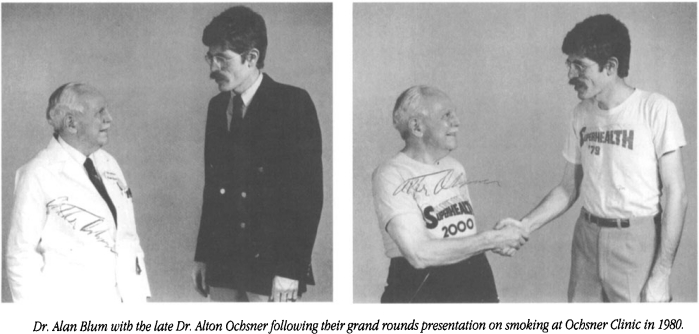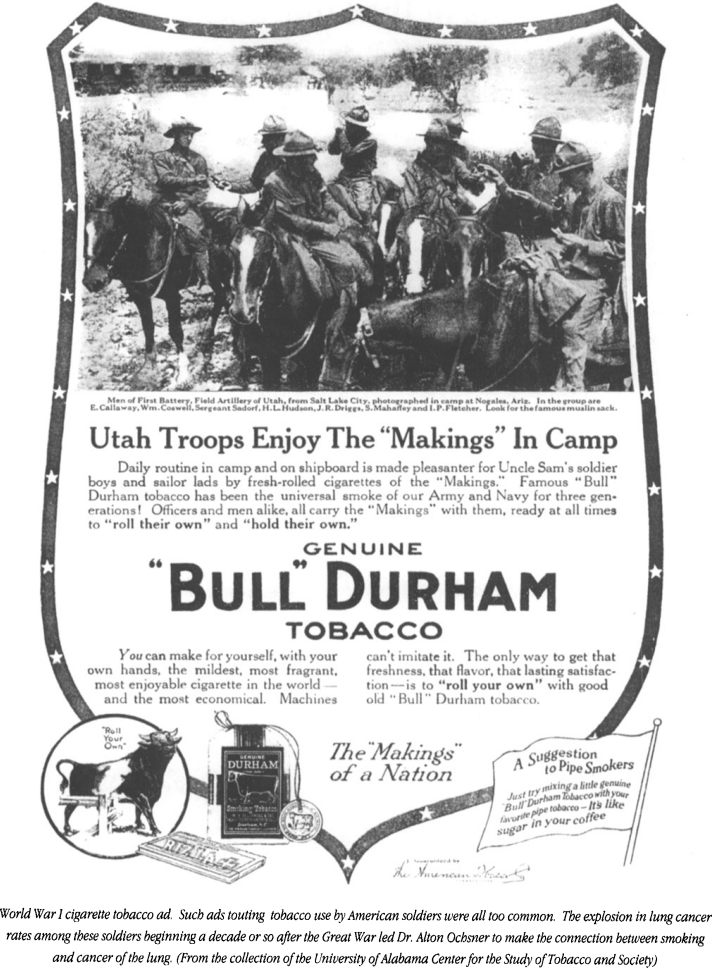The story was told by a physician who had just heard Dr. Ochsner, at the age of 84, deliver one of the major scientific addresses at the annual meeting of the American Academy of Family Physicians in 1980; the listener had found his presentation on the same topic as dynamic and compelling as it was 30 years before. Even if Ochsner, who died on September 24, 1981, had not been among the first physicians to make the connection between smoking and lung cancer, he would still be remembered as one of the foremost thoracic surgeons and medical teachers in history. Named chairman of surgery at Tulane University at the age of 30, he went on to found the Ochsner Foundation Hospital (named after him as a sign of admiration by his physician-co-founders).
Alton Ochsner's persistent belief that cigarette smoking was the principal cause of the growing epidemic of lung cancer—a theory he publicized throughout the 1940s in the face of ridicule and vituperative attacks even from within the medical profession—symbolized his energetic drive to improve public health. In 1919, lung cancer was such a rare disease that Ochsner's entire junior medical school class at Washington University's Barnes Hospital was asked to witness the autopsy of a man who had died from it. The professor, Dr. George Dock, believed that no one in the class would ever again see another such case. Seventeen years later, after having been a surgeon for more than a decade, Ochsner did see his next case of lung cancer—nine cases, in fact, in a period of just six months. Because all the patients were men who had taken up the newly mass-advertised practice of smoking while serving as soldiers in World War I [see p103 and 160], he had the temerity to suggest that cigarette smoking was responsible.
By 1952 he and his colleagues, Drs. Michael DeBakey and Paul DeCamp, could write in the Journal of the American Medical Association, “There is a distinct parallelism between the sale of cigarettes and the incidence of bronchogenic carcinoma” (1). They accurately predicted that the death rate from lung cancer would escalate as long as smoking continued to exist and that lung cancer would be the leading cause of death from cancer. So controversial was Ochsner that prior to an appearance on Meet the Press in the mid-1950s, he was told he would not be permitted to mention on the air the possible causal relationship between cigarette smoking and lung cancer.
Barely a month following publication in January 1964 of the landmark report of the Surgeon General on smoking, the American Medical Association (AMA) became the only major health organization to join the industry in opposing the immediate implementation of warning labels on all cigarette packs and advertisements. At a symposium sponsored by the American Cancer Society, an angry Dr. Ochsner charged that the AMA was “derelict” in its duty as a leader in health matters to educate the public on the findings of the Surgeon General's report. Moreover, he characterized the projected multi-million dollar long-term AMA research program on smoking, funded entirely by the tobacco industry, as “just delaying tactics” to prevent taking action to reduce demand for tobacco. The AMA countered that Dr. Ochsner's viewpoint was “extreme.”
Indeed, for decades before the Surgeon General's report, Dr. Ochsner had endured considerable ridicule and derision even from some doctors for his outspoken opinions about the hazards of smoking. His perennial reply: “Only two kinds of physicians do not accept the evidence of a causal relationship between cigarette smoking and cancer: employees of the tobacco industry and some addicted to cigarette smoking” (2).
Long after the AMA's research program had begun, Ochsner vehemently opposed the premise that additional research studies were needed to prove that smoking caused lung cancer. In his essay “The Hazard of Bronchogenic Carcinoma” he wrote, “Until we find an animal which is foolish enough to smoke like human beings, it will probably not be possible to produce bronchogenic cancer in the experimental animal. However, with the proof in the human being, additional animal experimentation is not necessary” (2).
Ochsner would drive home this point with the story of a cavalry officer who suspected his wife of being unfaithful. After telling his wife he was departing for a military campaign, the officer hid across the street and witnessed a soldier from another regiment arriving at his house and being warmly welcomed by his wife. He watched through the window as they kissed, embraced, disrobed, ran upstairs, embraced again, and leaped into bed. Then the lights were turned off and the officer exclaimed, “Damn, if I only had proof!”
He sardonically contrasted the Food and Drug Administration's quick removal of thalidomide from the market with governmental inaction on cigarettes. “If there were one tenth the evidence that the Brooklyn Bridge was unsafe for traffic as there is that cancer of the lung is caused by cigarette smoking, the Brooklyn Bridge would be closed to traffic within 24 hours until it could be determined whether it was safe” (3). It was all about money: “Our complacency about this much greater health hazard is undoubtedly due to the economic significance of tobacco” (3).
In the 1960s and 1970s Ochsner pointed out that as tragic as is the fatality rate from lung cancer due to smoking, it pales in comparison to cigarette-related deaths from heart attack and emphysema. After the widespread publicity accorded the breast cancer experiences of First Lady Betty Ford and the wife of the Vice President, Happy Rockefeller, Ochsner castigated the mass media for ignoring lung cancer—a more preventable problem and soon to become a greater cause of death among women. Noting the absurdity of women who continued to smoke as a means of keeping their weight down, Ochsner wondered aloud, “Who wants to be a svelte corpse?”
He also criticized insurance companies, having tried for years to get them to give preferential rates to non-smokers. “The companies' own statistics show that heavy smokers live about eight years less,” he said, “but premiums appear to be set according to death rates for smokers. Company profits are thus boosted at the expense of nonsmokers who do not only pay extra but live longer.” He surmised-correctly-that insurance companies have tobacco stocks in their portfolios.
Among the first to debunk the government's $40 million research effort to develop a “safe cigarette,” Ochsner, whenever he was asked if filtered cigarettes had any value, would reply, “Yes, for the tobacco industry. They help sell more cigarettes.”
Dr. John Ochsner, emeritus professor of surgery at the Ochsner Clinic, recalls that all teenagers took up smoking for a time, and the Ochsner children were no exception. “Not only did we get the lecture from Dad,” he said in a recent interview, “but when he found out my sister was smoking he put an article on her bed every night—and if he didn't have an article, he wrote one.” Nor were colleagues immune to his wrath. Dr. Minis Gage, his closest friend, once told John Ochsner, “I burn more holes in my pockets stuffing cigarettes when your dad comes around!”
Although pleased that his father's work has been cited as the cornerstone of legislative actions to punish, restrict, and regulate the tobacco industry, Dr. John Ochsner does not believe that his father would have approved of the efforts by some plaintiffs' attorneys to profit from the issue: “Dad had no love for people who would capitalize off the suffering of others.”
Obituaries of Ochsner depicted him as a foe of smoking and a nemesis of the tobacco industry. It would be more accurate to depict him as a forceful advocate for good health. Although a surgeon, he preferred to speak out about measures that could prevent the need for the knife. “Even though relief of symptoms and prolongation of life can be obtained by surgery and other therapeutic measures,” he wrote in 1966, “only through prevention, mainly abstinence from smoking, can one hope to attain better results in the treatment of lung cancer” (4).
There is little on the horizon to challenge that statement.
References
- 1.Ochsner A, DeBakey ME, DeCamp PT et al. Bronchogenic carcinoma, its frequency diagnosis and early treatment. JAMA. 1952;148:681–697. doi: 10.1001/jama.1952.02930090001001. [DOI] [PubMed] [Google Scholar]
- 2.Ochsner A. The hazard of bronchogenic carcinoma. Milit Med. 1963;128:1167–1172. [PubMed] [Google Scholar]
- 3.Ochsner A. The increasing menace of bronchogenic cancer. N Physician. 1964;13:29–36. [PubMed] [Google Scholar]
- 4. Ochsner A. Bronchogenic carcinoma stages III and IV: palliation by surgery JAMA 1966. 196: 852 [DOI] [PubMed] [Google Scholar]




